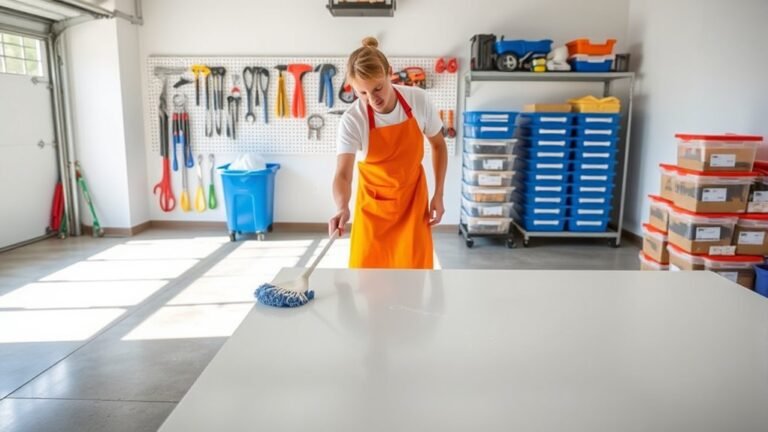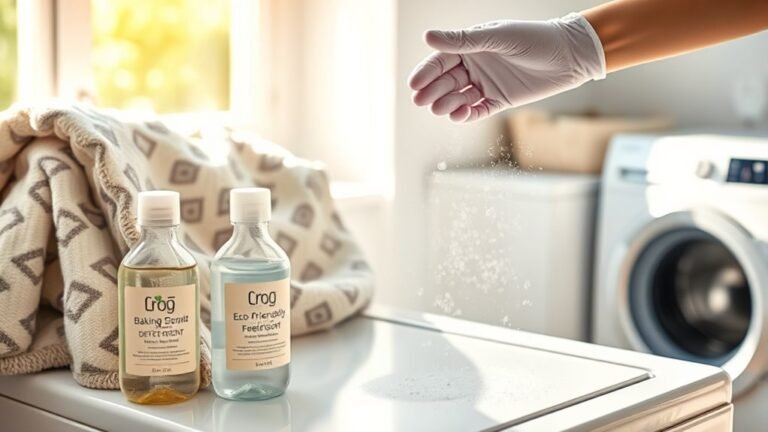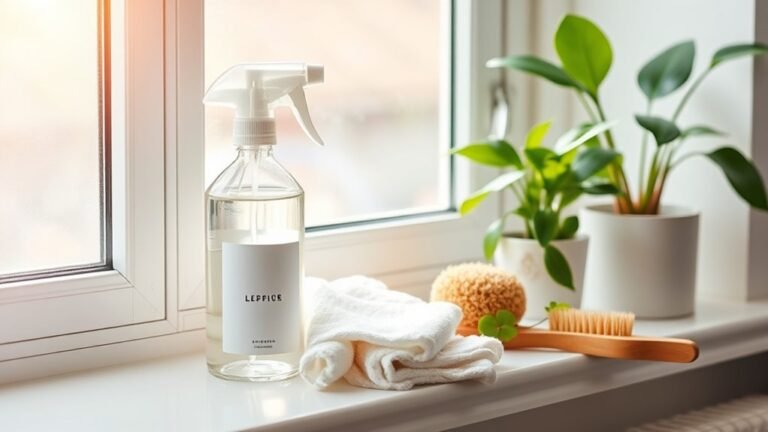Best Way to Sanitize Your Toys
You should sanitize your child’s toys regularly to keep germs at bay and guarantee safe play. Use mild soap and water for plastic toys and gentle spot cleaning for fabric ones, always checking care labels. Natural disinfectants like diluted vinegar or baking soda are great for a child-friendly clean. Make certain toys air dry completely to prevent mold. With simple steps and good habits, you can maintain a healthy play environment. If you want to explore more detailed tips and tricks, there’s plenty to reflect upon.
Importance of Regular Toy Sanitization

Although toys bring joy and learning, they can also harbor germs that put your child’s health at risk. You want your little one to explore freely, but without the worry of harmful bacteria. Regular toy sanitization offers significant health benefits by reducing the chance of illness. When you make cleaning a routine, you actively prevent germs from multiplying and spreading. This simple habit safeguards your child’s immune system and keeps playtime safe and carefree. You don’t have to sacrifice freedom for protection; consistent germ prevention means your child can enjoy their toys without interruption. Prioritizing regular sanitization empowers you to maintain a healthy environment, letting your family embrace play and discovery with confidence and peace of mind.
Safe Cleaning Solutions for Different Toy Materials
You’ll want to use different cleaning methods depending on the toy’s material to keep them safe and intact. For plastic toys, a mild soap and water solution usually works well, while fabric toys often need gentler approaches like spot cleaning or using a steam cleaner. Let’s explore the best ways to sanitize each type without causing damage.
Cleaning Plastic Toys
When cleaning plastic toys, choosing the right solution is key to keeping them safe and durable. You want to avoid harsh chemicals that could degrade the plastic or leave harmful residues. Instead, opt for eco friendly options like a simple mix of warm water and mild dish soap. This combo effectively cleans while respecting toy safety and the environment. For tougher grime, a soft cloth or toothbrush helps without scratching. After washing, rinse thoroughly and let toys air dry completely to prevent moisture buildup. Avoid bleach or ammonia-based cleaners, as they can damage plastic and pose health risks. Sticking to gentle, eco conscious methods gives you freedom to clean confidently without compromising the toys’ integrity or your values.
Sanitizing Fabric Toys
Sanitizing fabric toys requires a gentle approach to protect their softness and colors while eliminating germs. Different fabric toy types—like plush animals, cloth dolls, or soft blocks—demand tailored fabric care. First, check the care label to see if your toy can be machine washed or needs hand cleaning. For machine-safe toys, use a mild detergent on a gentle cycle and air dry to avoid damage. For more delicate pieces, spot clean with a mixture of water and baby-safe detergent, then wipe down with a damp cloth. Avoid harsh chemicals that can degrade fibers or cause skin irritation. By choosing the right method, you keep your fabric toys fresh, safe, and ready for endless play without sacrificing their cozy feel.
Step-by-Step Guide to Sanitizing Plastic Toys

You’ll need a few basic cleaning supplies to get started, like mild soap, water, and a soft cloth or brush. I’ll walk you through the best washing techniques to make sure every corner of the plastic toys gets clean. Then, we’ll cover how to dry and store them properly to keep them safe and ready for play.
Cleaning Supplies Needed
To get started, gather a few essential cleaning supplies that’ll make sanitizing plastic toys quick and effective. First, opt for eco friendly cleaners—they’re safe for kids, gentle on the environment, and still tough on germs. You’ll also need a soft brush or sponge to reach nooks and crannies without scratching the toys. A basin or large bowl works perfectly for soaking, while microfiber cloths help with drying. Don’t forget gloves to protect your hands and a spray bottle for easy application of your cleaner. Having these essential supplies ready guarantees you can clean thoroughly without hassle, giving you the freedom to keep toys safe and fresh without relying on harsh chemicals or complicated routines.
Washing Techniques Explained
There are a few simple steps you can follow to thoroughly clean plastic toys and keep them germ-free. Start by wiping down the toys with disinfectant wipes to remove surface dirt and germs quickly. For a deeper clean, steam cleaning is your friend—it’s chemical-free and penetrates hard-to-reach spots. After steam cleaning, give the toys a quick rinse with warm water to remove loosened grime.
| Step | Why It Matters |
|---|---|
| Disinfectant Wipes | Quick, easy surface sanitation |
| Steam Cleaning | Deep clean without harsh chemicals |
| Warm Water Rinse | Removes loosened dirt |
| Air Dry | Prevents moisture buildup |
Following these steps helps you maintain clean toys, giving your loved ones freedom to play safely.
Drying and Storage Tips
Once the toys are thoroughly cleaned, drying them properly is essential to prevent mold and bacteria growth. You want to choose drying methods that let air circulate freely, like laying toys on a clean towel in a well-ventilated space. Avoid stacking toys while wet, as trapped moisture invites germs. If you’re short on time, using a fan can speed things up without causing damage. For storage solutions, pick containers that keep toys dust-free but still allow airflow, like breathable bins or mesh bags. Store toys in a cool, dry place away from direct sunlight to maintain their quality. By mastering these drying and storage tips, you’ll keep your toys safe and ready for endless fun, all while embracing the freedom to play worry-free.
Best Practices for Cleaning Fabric and Plush Toys

Anyone who’s cared for fabric or plush toys knows they need gentle but effective cleaning to stay safe and fresh. For fabric care, always check the label first—many can be machine washed on a delicate cycle with mild detergent. Use cold water to prevent colors from fading or bleeding. When it comes to plush maintenance, spot cleaning works wonders for small stains; just dab with a damp cloth and gentle soap. Avoid harsh scrubbing that could damage fibers or stuffing. After cleaning, air dry toys thoroughly to prevent mold or mildew, ideally in a sunny, well-ventilated space. By following these best practices, you’ll keep your toys looking great while maintaining a healthy play environment without sacrificing the freedom to enjoy them daily.
Using Natural and Child-Friendly Disinfectants
Although you want to keep toys clean and safe, harsh chemicals aren’t always the best choice—especially around children. Luckily, natural alternatives offer effective, child-friendly disinfecting without the risks tied to synthetic products. You can turn to eco friendly options like diluted vinegar, baking soda, or gentle essential oils, which sanitize toys while respecting your child’s health and the planet. These choices give you freedom from worrying about toxic residues and environmental harm. Just mix a safe solution, apply it to toys, and let them air dry. This approach keeps your cleaning routine simple, safe, and sustainable. Embracing natural disinfectants means you’re protecting both your family and the world they’ll grow up in, without sacrificing cleanliness.
Tips for Maintaining Toy Cleanliness Between Sanitizations
Keeping toys sanitized with natural disinfectants is a great start, but maintaining their cleanliness day-to-day helps reduce the need for frequent deep cleaning. Here are some practical tips to keep your child’s toys fresh and safe without feeling trapped by constant scrubbing:
- Implement toy rotation: Limit the number of toys out at once. Store extras away to minimize germs spreading and keep playtime exciting.
- Use smart storage solutions: Choose bins or shelves that allow good airflow, preventing moisture buildup and mold.
- Encourage hand washing: Teach kids to wash their hands before and after play to reduce dirt and bacteria.
- Spot clean regularly: Wipe down frequently touched toys with a damp cloth to keep them tidy between full sanitizations.
These simple habits give you freedom to enjoy playtime without worry.
Frequently Asked Questions
How Often Should Electronic Toys Be Sanitized?
How often should you sanitize electronic toys? Think of them as tiny gadgets in constant contact with your hands and face, making regular cleaning essential. Following frequency guidelines, you should sanitize them after every few uses or at least once a week to maintain hygiene. Electronic toy maintenance isn’t just about function but also your freedom to enjoy them without worry. Keeping them clean means you’re protecting yourself while embracing carefree playtime.
Can Sanitizing Toys Affect Their Durability?
Yes, sanitizing methods can affect your toys’ durability, depending on the toy materials. Harsh chemicals or excessive moisture might weaken plastics or damage electronic components. You’ll want to choose gentle sanitizing methods that suit your toy’s material—like using mild soap, diluted disinfectants, or wipes made for electronics. By picking the right approach, you can keep your toys clean without sacrificing their lifespan, giving you the freedom to enjoy them safely.
Are UV Light Sanitizers Safe for All Toy Types?
When you’re thinking about UV light sanitizers, remember their UV effectiveness depends on exposure time and intensity. They work great on hard, non-porous toy materials like plastic or metal. But they might not be safe for softer or porous toys, as UV can degrade some materials over time. You’ve got the freedom to choose, so always check your toy’s material before using UV sanitizers to keep them safe and lasting longer.
How to Sanitize Toys With Battery Compartments Safely?
When sanitizing toys with battery compartments, you’ve got to follow battery safety tips to avoid damage. First, remove the batteries before cleaning to prevent moisture from causing corrosion. Use a damp cloth with mild soap to wipe the toy’s surface, avoiding soaking or submerging it. Toy cleaning methods like disinfectant wipes or gentle sprays work well, but don’t let liquids seep into the battery area. This way, you keep your toys clean and safe!
What to Do if a Toy Sanitizer Causes Allergic Reactions?
Ever thought about how it feels when allergy symptoms suddenly flare up after using something meant to keep you safe? If a toy sanitizer causes you irritation or hives, it’s a clear sign to stop using it. Don’t trap yourself in discomfort—explore alternative sanitizers like natural solutions or steam cleaning that won’t trigger allergies. Your freedom to enjoy and care for your toys safely is worth finding gentler options that suit you perfectly.






